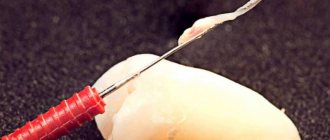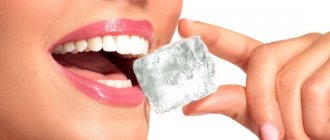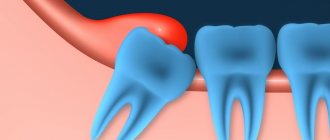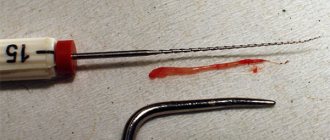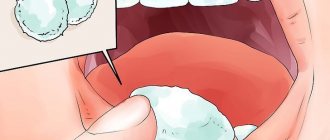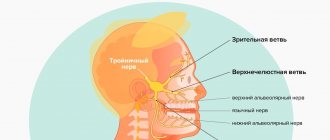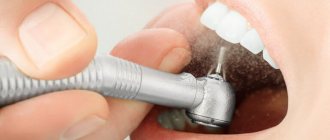Toothache is explained by the presence of a nerve - a process that connects the human nervous system with the dental crown.
If you have a pain syndrome, it is important to know how you can kill the nerve yourself at home using folk remedies (iodine, alcohol, vinegar, garlic, etc.), as well as how to quickly relieve pain at home with the help of medications, which will be discussed in detail Further.
What is a nerve and what is it for?
Human teeth consist of an outer bony part (crown) and numerous blood vessels inside.
Blood and lymphatic vessels, small fibers and a whole network of nerve endings are located inside - in the pulp, which is inaccessible to the human eye. Nerve fibers go far into the roots along the canal. This is the natural anatomical structure of the human tooth.
At human birth, the nerve is a catalyst for the process of growth and proper nutrition of the tooth. Afterwards, the function changes - the endings are an indicator of the ongoing destruction of the outer crown.
How long does it take to die
Killing the nerve is called a devitalization procedure. This relieves periodic pain when eating cold, hot or sweet foods. The nerve dies from a day to several days or even months - it all depends on the method used for this. If a special remedy is used, then you won’t have to wait long - the well-known arsenic neutralizes nerve endings within 24 hours or even less.
If the decision was made not to touch the entire destroyed tooth, then you will have to endure periodic unbearable pain for several months - killing occurs due to developing dangerous bacteria. It is prohibited to resort to such a method, because it is fraught with the formation of a cyst due to the discarded “waste” into the gums and pulp.
This is important: Devitalization involves stopping the nutrition of the tooth, so after some time the crown will darken. The way out of the situation is treatment - the use of a filling will close the exposed roots and gums, and also prevent darkening of the bone part.
In what cases is it necessary to kill him?
The dental nerve is killed in most cases for painless treatment. Moreover, deformation of the pulp - drilling the tooth to apply a filling - will subsequently provoke partial “exposure” of the nerve endings. As a result, even after treatment the person will experience pain.
Among all the reasons for killing the dental nerve are:
- prosthetics;
- deep carious cavity - when caries has affected the deep layers of the pulp;
- previous poor-quality dental treatment – pain occurred after dental intervention;
- mechanical injury.
Prerequisites also include inflammation of the pulp, developing periodontitis and other destructive processes of the dental crown.
Main indications for depulpation
- Deep caries. It’s not for nothing that dentists convince patients to visit their offices at least once every six months. Caries can occur completely unnoticed and painlessly, but a small black dot can grow in a short time and reach the soft tissues, then depulpation can no longer be avoided.
- Correction of the consequences of unsuccessful treatment. When removing hard carious tissue, the doctor may get too close to the pulp chamber and inadvertently open it. Then you will have to carry out, if not complete, then partial amputation of the nerve.
- Prosthetics. The technology for installing most fixed dentures involves opening the hard tissues of the tooth and manipulating the pulp chamber. In this case, it is impossible to do without removing the nerve, especially if the tooth grows at an angle.
- Injuries and mechanical damage. The consequence of a strong blow can be damage to the enamel and deep chips, inevitably affecting the nerve. In this case, it is unlikely that it will be possible to preserve it, especially in the front teeth. If the extreme molars are affected, then there is a possibility of saving some of the nerve endings by performing only partial depulpation.
Important! Prolonged acute toothache is one of the main signals that caries has already reached the pulp chamber. But it happens that the chronic form of pulpitis is absolutely painless and is detected only with a thorough dental examination. Therefore, if the doctor insists on removing the nerve, you should trust him.
Symptoms
You can find out about the destruction of the pulp and the impact on the dental nerve by the existing unpleasant symptoms :
- prolonged pain - in most cases occurs after eating cold or hot, indicates inflammation of the pulp, tissue death;
- severe – acute pain can also cause the development of pulpitis, often indicating the formation of a crack in the dentin (the second layer of the tooth);
- aching - this type of pain indicates the beginning of destruction and partial exposure of the pulp;
- attacks - pain occurs only when pressure is applied to the tooth.
The formation of a characteristic unpleasant sensation when cold or hot is also noted. This occurs due to increased sensitivity of the tooth, which is the result of exposure of the nerve or root. Sometimes such symptoms indicate improper use of a toothbrush or the use of inappropriate toothpaste, which gradually leads to abrasion of the enamel.
Professional treatment
Its tactics and volume are determined by the doctor, and it depends on the causes of the problem and the condition of the diseased tooth. After an in-person examination, if necessary, the specialist sends the patient for an x-ray in order to accurately determine the location of the lesion and examine the condition of the root and dental tissues.
Based on a preliminary study, the following assistance can be provided to the patient:
- Treatment of caries;
- Depulpation of the tooth with treatment and subsequent filling of the dental canals;
- If its tissues are severely damaged, it may be necessary to install a crown or other types of prostheses (for example, veneers, lumineers);
- If the cause of the pain lies in a root disease, if possible, it is treated by opening the canals. It is possible that resection of its apex will be required to eliminate the source of inflammation and preserve the tooth;
- In some cases, it is not possible to avoid completely removing the latter.
If discomfort occurs after filling, and the reason lies in improper treatment, the filling is opened, the canals are treated, if necessary, and then the filling is repeated.
How dentists do it
For devitalization, it is better to contact dentists, who will conduct a thorough examination, determining the cause of the toothache. Specialists use special means to quickly kill the nerve and stop the patient’s suffering.
Arsenic pastes
Arsenic is the most common dental nerve killer used in dentistry. Previously, it was used in its “pure” form, mixed with suitable additives.
Today we offer ready-made formulations :
- Devit-ars - promotes rapid neutralization of the nerve, has an analgesic effect due to the content of lidocaine hydrochloride. The mixture is applied for a day, but with a special tooth structure, exposure is required for 2 days.
- Kaustinerv Rapid - the main component in the form of arsenic anhydride is contained in only one third of the presented composition. The rest is lidocaine, menthol, phenol and other additives. As a result, it is used to kill the nerve for 2-3 days.
- Septodont is a paste with a wide range of effects, actively used for the treatment of periodontitis. Has antibacterial and antifungal effects.
- Pulparsen - one third consists of the main substance arsenic, contains the antiseptic camphor.
- Causticin is also one third of arsenic anhydride, the rest is reserved for antiseptic and analgesic substances. Use to neutralize the dental nerve for at least 2 days.
Devit Ars Kaustinerv Septodont
Attention: The use of arsenic-based products must be carried out in strict compliance with the instructions and only with the permission of a doctor. Violation of recommendations may lead to irreversible consequences for human health.
Arsenic-free pastes
Such drugs include Devit-P and Devit-S . These agents are based on paraformaldehyde, lidocaine has an anesthetic effect, and creosote has an antimicrobial effect. Due to the fact that the drugs do not contain arsenic, their use takes place within 10 days.
Devit P Devit S
The advantage of the presented products is the absence of a substance dangerous to the human body and the need to clean the dental canal before treatment.
Process steps
Once the medication is applied to the exposed pulp, the process of neutralizing the dental nerve begins. Due to the influence of basic substances, cell respiration is impaired, resulting in decomposition of the constituent nerve branches.
Watch how a nerve is removed in dentistry:
Going to the dentist is the best solution for this pathology
We tell you what to do if the nerve of the tooth is exposed. The doctor will help you get rid of not only painful symptoms, but also the problem itself that provokes them.
On a note! If you have an exposed tooth nerve, then before understanding how to treat, the doctor will use a visual examination and x-ray to determine the extent of the damage.
Conservative (biological) treatment method with pulp preservation
In case of an inflammatory process that has slightly affected the pulp, and in the absence of negative changes in the periodontal tissues, conservative therapy with preservation of the nerve is possible. In this case, the specialist will simply clean the root canals and put medications with calcium hydroxide inside and install a temporary filling. Next, dynamic observation is carried out. In case of positive dynamics, the temporary filling is replaced with a permanent one. From the first visit to the clinic to the final one it can take from several weeks to 6 months.
Surgical methods
In most cases, the pulp is severely inflamed because it has time to be exposed to harmful bacteria while you are wondering whether to go to the doctor or wait a little and be patient. In this case, the specialist, as a rule, decides to remove it partially (vital amputation) or completely (extirpation).
Most often, the nerve is completely removed. But the procedure for killing it and removing it from the tooth cavity can be carried out in different ways. The most modern - vital extirpation, that is, the living pulp is removed - is performed in one visit to the dental office, under local anesthesia, using special tools - files and pulp extractors.
However, many clinics still practice treatment in two stages. If a tooth hurts or a nerve is exposed, this is what the doctor will do:
- at the first stage: the specialist drills out hard tissues, opens access to the root canals, puts a special devitalizing paste inside and closes the cavity with a temporary filling. Some pastes contain arsenic, but they are less toxic and safer than those used previously, and also contain lidocaine for pain relief and antiseptics. Killing of the pulp usually occurs within 1-3 days. Also today, in some clinics, arsenic-free formulations are used for these purposes, which are considered even safer - these can remain in the mouth for up to 10 days,
- at the second appointment: the temporary filling and paste are removed, the dead pulp is removed, the tissues and canals are well cleaned, and a permanent filling is placed. X-ray control is required, with the help of which the doctor can evaluate the quality of the work done and make sure that the pulp is completely removed.
“I faced unbearable pain due to an exposed nerve. The pills did not help relieve the pain at all. The clinic immediately offered to remove the pulp and then put a crown on top. Otherwise, they said, the tooth will not last long in this condition. They removed the pulp in one sitting, immediately put on a temporary crown, and 2 weeks later - a permanent one.”
Ris, review from yell.ru
How to kill with drugs
The use of the above products requires careful preparation, and then high-quality dental treatment.
The entire process of nerve removal includes the following steps:
- Opening the tooth - it is necessary to fully expose the pulp.
- Application of medication and temporary filling.
- Removing the applied composition, cleaning the canals, if necessary.
- Additional disinfection.
- Filling or other type of treatment.
- Control photo.
If you have severe pain, it is recommended to consult a dentist to identify the causes and develop appropriate treatment. Otherwise, you can only make the situation worse.
How to remove a nerve at home?
This method of treatment is considered prohibited, because a person can harm his health. Dentists recommend resorting to it only if other methods have not helped, you can’t get to a specialist, and the pain does not calm down.
Pulp removal at home must be carried out carefully, after first assessing the patient’s condition and determining whether there is periodontitis, an infection. If the gums are inflamed and the pain spreads to several teeth at once, then the procedure is dangerous. It's better to see a doctor.
Before removal, clean the cavity well, put in it homemade medicine or purchased at a pharmacy, which will kill the nerve.
Preparing for the procedure at home
Self-killing a nerve at home begins with preparation, which takes place in the following sequence :
Brushing your teeth – It is important to thoroughly clean your teeth, especially the one that will be treated. When brushing, all actions are smooth and without pressing with a toothbrush - this can provoke a new attack of pain.
Disinfection of available instruments - applying a paste or other product can be done in different ways using the most unexpected tools. All used items must be disinfected with alcohol or vodka.
Cleaning the hollow of a tooth - take a needle or thin wire and clean with careful and leisurely movements.
Rinsing the tooth with an antiseptic - after all procedures, the oral cavity is simply rinsed with a special antiseptic solution.
After the preparation has been completed, they begin to search for a tooth that has no prospects for treatment. To do this, touch each person with a cooled cotton ball, “listening” to the pain syndrome. If the pain is severe but short-lived, then the tooth should be treated by a dentist. If the pain goes away only after a few minutes, the tooth can be “finished off.”
Depulping process
The tooth that is causing concern most often has some kind of cavity or chip. It is in such a place that you should put a tampon, pre-moistened in a solution that you prepared yourself. You can also use the following tools:
- Alcohol is not able to remove the nerve on its own, but will act as a good pain reliever. You can also relieve pain symptoms by simply rinsing your mouth.
- Powder. It is put into the wound, but only in a small proportion, so that intoxication of the body does not occur.
- Vinegar - this method is used with extreme caution, because the solution can easily cause a burn in the body’s mucous membranes. The tampon should only be placed on the nerve, and an anesthetic should be used before doing so.
- Arsenic is sometimes used in modern dentistry, but only in ointments and salts, having selected the desired concentration of the drug. It is not entirely suitable for home use. The desire to relieve the nasty pain is strong, but you should always remember that arsenic is a poison, the thoughtless use of which can cause poisoning and a threat to life.
- Zinc - the easiest way to find this element is to take a newspaper, which will contain a large amount of printing ink (lots of inscriptions, photographs). The newspaper should be burned, and the ashes from it, collected on a tampon, should be placed on a previously cleaned dental canal. The tampon must be in the mouth for 12 hours.
- Garlic, which is thoroughly crushed, is applied to the sore hole. In this case, a clove of garlic can be replaced with simple ground pepper.
After the nerve has been removed, you will still need to see a dentist ; the visit should be completed within 14 days. A medical examination must be performed to ensure that infection does not occur, as well as to prevent tooth decay.
If you were unable to kill the dental nerve yourself without negative consequences (intoxication, burn of the mucous membrane), then it is simply unacceptable to postpone a visit to the doctor.
Medicines for pulp removal
You can depulpate a tooth using not only simple home remedies such as vinegar, alcohol, propolis, but also using specialized medicinal-type compounds. They are based on arsenic and formaldehyde.
Depending on the concentration of the drug, the following ointments can be distinguished:
- Krazefon - main components: thymol, p-chlorophenol, expicivitis, dexamethasone. This product does not have an irritating effect, so it will not affect the gums at all; it can be successfully combined with pre-cleaning with antiseptics or the use of painkillers. It is used as drops. After using the drug, the cavity or crown where the tampon was placed should be rinsed well with water.
- Kaustirnev Rapid - means 30% arsenic anhydride, the remaining part is auxiliary substances that act as conductors of active substances. These include menthol, phenol, hydrochloric ephedrine, lidocaine. How long do you need to wait for the devitalization effect? This directly depends on how deep the nerve is under the dentin. The medicine will work most quickly when applied directly to the pulp. The action takes place over several days.
- Devit ARS - removal of a nerve using this drug is considered easy and painless. The main component of the product is the same as Kaustinerva; lidocaine can also be found in the composition. The risk of infection is prevented by additives such as metacresol, chlorophenol, and other types of antiseptics. It may take 1–2 days to completely kill the nerve, since the main thing here is the structure of the tooth itself. You can buy Devit ARS in a syringe. Yes, and as 100 universal dosages. Their composition and concentration vary slightly.
How to kill an open dental nerve yourself at home
There are several ways to remove the nerve yourself, which is carried out after the preparation presented above.
Here you can use:
| Powder | A few grains are simply poured into the open channel. The method is dangerous to use because it entails corresponding intoxication. |
| Zinc | It is obtained from printing house ink by burning a small piece of newspaper. For the procedure, you need to use an anesthetic - drink Ketanov, apply Baralgin. Afterwards, a moistened cotton ball is dumped in the ashes of the burnt newspaper until it reaches a black color. Afterwards, you need to put it in the tooth and cover it with a clean one. |
| Alcohol | A cotton ball is soaked in alcohol and placed in the exposed tooth. You can prepare a solution - mix alcohol with water in a 1:1 ratio and rinse your mouth with it. This way you can relieve pain for a short time. |
| Vinegar | For killing, only 6% product is used. A ball of cotton wool is also soaked in it and placed in the tooth. You should be careful when using this method, since vinegar can cause burns to the mucous membranes. |
| Arsenic | Using this method is strictly prohibited at home. Here you need to use special medicines on arsenic bases. |
| Iodine | A cotton ball soaked in iodine is placed into the tooth and left for a day. |
Of all these methods, iodine is the safest. It is used carefully, monitoring the position of the cotton temporary filling - it is necessary to prevent the product from getting on the gums and mucous membranes.
The nerve has died - how to remove it at home?
You will not be able to remove the nerve yourself at home. It is better to consult a doctor who will use a special pulp extractor. Home removal can lead to disruption of the integrity of the nerve, which may cause the pain to recur.
Please note: Some people, having killed a nerve at home, try to remove it themselves using a regular needle. This method is theoretically correct, but in practice it always leads to complications.
Seeing a dentist even after self-killing a nerve is not a mistake; no punishment will follow for this. Only a specialist will assess the condition of the tooth.
Watch the video about why it is dangerous to kill a nerve at home:
When is nerve removal indicated?
If a person experiences severe pain that intensifies at night, and there is pulsation, then in this case depulpation cannot be avoided. But there are situations when there is no pain, but you still have to remove the nerve. Before answering the question of how to kill a dental nerve, let’s look at the reasons that lead to such a procedure:
- Pulpitis. These are the consequences of previously untreated caries, which gradually destroys the tooth and reaches the pulp, causing an inflammatory process. As a result, pain appears that requires radical measures: removal of the nerve and filling of the canals.
- Cyst or granuloma. They also contribute to the disruption of the sensitive area of the tooth and are removed only through the canals.
- Tooth injury. Any damage results in damage to the tooth enamel, which affects the nerve. If the frontal area is injured, then complete depulpation is performed. If the problem affects the back teeth, it is possible to partially remove the nerve.
- Prosthetics. If a person needs to get a bridge or crown, then the nerve must first be killed. This way you can reduce the risk of developing inflammation under the crown.
A specialist knows how to kill the dental nerve, so at the first symptoms it is better to seek qualified help.
The safest folk methods that will help calm the nerve and relieve pain
There are safer methods used at home to devitalize the dental nerve.
These include:
| Salt | This method involves using a saline solution to rinse your mouth. To prepare, mix a teaspoon of salt in a glass of warm water. This treatment will relieve pain in the inflamed nerve of the tooth for a short time. |
| Salt and garlic | A clove of garlic is ground into a paste and mixed with a small amount of salt. Next, the resulting mixture is placed into the open canal (hole in the tooth) until the pain syndrome is completely eliminated. |
| Comfrey flower | Make a root tincture - for this, 10 g of the main component is poured with 50 ml of alcohol and left for 10 days. A cotton ball is soaked in the tincture and placed in the tooth canal. |
| Propolis | Pour 30 g of propolis into 200 ml of alcohol and leave the mixture for 10 days. The finished tincture can be purchased at the pharmacy. Soak a cotton ball in the solution and place it in the tooth until the pain disappears. |
| Hydrogen peroxide | Use a 3% hydrogen solution, diluting it in water in a ratio of 2:1. A cotton swab is also soaked in the resulting liquid and applied to the exposed nerve. |
| Onion peel | It is used to prepare a decoction that can be used to rinse your mouth to get rid of pain. Pour about 30 g of husk into half a liter of boiling water and put on fire, bring to a boil, boil for 5 minutes. Then the broth is removed from the heat and kept for another 2 hours. Afterwards you can use it as directed, it will help calm the nerve and reduce pain. |
| Clove essential oil | Ready-made oil is purchased at a specialized store. A drop of the product should be placed on a cotton pad and applied to the sore tooth. |
| Lilac | An effective spring remedy. It is necessary to collect the leaves, chop them and pour half a liter of boiling water in the amount of 30 g. Then put on fire, bring to a boil, turn off the heat and leave for 2 hours. Simply rinse your mouth with the resulting decoction. |
| Wheat | If a toothache occurs, you need to drop the juice squeezed from the grains into the lesion. |
| Herbal infusions | Here you can use chamomile, lemon balm, cloves, sage, mint and oak bark for preparation. Rinse your mouth with the prepared infusions immediately when pain occurs. This recipe notes that it is better to use a warm infusion for processing. |
| Pepper | Pepper and salt mixed in equal quantities must be poured into the resulting hole. |
All the given recipes for killing the dental nerve are used immediately when pain occurs. Keep tampons and components in the canal until pain is completely eliminated.
How to relieve pain with medications
If you do not want to deal with the above methods of tooth pain relief, you can use ready-made medications. All of them are intended only to eliminate pain; devitalization of the dental nerve does not occur in this case.
The most popular means include:
| Ketones | The most effective medicine for pain relief. Approved for use only by adults, it has a large number of contraindications. |
| Ketorol | An analogue of Ketanov with the same positive properties. It has many contraindications, which include diseases of the respiratory system, liver disorders, and stomach pathologies. |
| Took | Can relieve pain of moderate intensity. For people with increased hypersensitivity or during pregnancy, it is better not to take it. |
| Moment | Recommended for use to relieve inflammation and relieve pain. Dangerous for use during pregnancy and lactation; not recommended in the presence of ulcers or any pathologies of the circulatory system. |
| Solpadeine | Recommended for use when it is necessary to quickly relieve pain and inflammation. Do not use if you have problems with blood pressure. |
| It is based on valerian tincture and contains additional substances. Effective in the presence of mild pain. The drug is used to rinse a diseased tooth. | |
| Validol or Carvalol | They belong to the group of emergency drugs. A cotton ball is soaked in one of these products and applied to the diseased tooth. |
This is important: The products presented must be used in accordance with the instructions from the manufacturers. It is important to exclude the presence of contraindications.
Wisdom teeth extraction
You can remove a wisdom tooth if you can loosen it and grab it tightly with your fingers. Place a cotton swab in front of the cheek on the area of the problem tooth. These teeth have long roots, making it almost impossible to remove them yourself. Tooth extraction requires a careful approach, but it is equally important to avoid future infection.
For this:
- Provide the empty hole with maximum peace;
- Brush your teeth, but be careful not to wash away the clot that has formed;
- To improve blood circulation in the injured area, apply warm, damp compresses to the gums;
- Rinse your mouth after every meal;
- Stick to a diet - hot and cold foods should be excluded;
- Use painkillers only when absolutely necessary, avoiding overdose.
Popular questions
Toothache often contributes to panic in the patient, which is why the most common questions are asked:
- The pain does not go away, what should I do? First, you should calm down and use another recipe to eliminate pain. If nothing helps, no matter how many remedies you try, you need to see a dentist.
- Arsenic does not kill the nerve, why and what to do? There may be several reasons for this - improper use or poor quality of the drug. It is recommended to change the arsenic-based product and increase the duration of exposure. If arsenic was applied by a doctor, you must contact him again for consultation.
- How to kill a tooth root? The root of the tooth cannot be killed; it should only be removed. This is often resorted to when a bone part is completely destroyed or in case of inflammation.
- Can a nerve in a tooth die on its own? The nerve can die on its own, but this will take a long time. Often its sensitivity is dulled, but when exposed to an “aggressive” component, the pain resumes.
- Is it possible to kill the dental nerve with analgin? Analgin and other similar drugs only eliminate pain, but cannot kill the nerve completely. When the effect of the pill wears off, the tooth will begin to hurt again.
- How do you electrocute a nerve? This method was used several years ago. According to patients, the procedure is unpleasant and quite painful. A special device was applied to the exposed nerve, which sent a charge of current. Microcurrent exposure led to cell death and burning of nerve vessels. As a result, its sensitivity decreased, and the removal was painless.
There are many issues of interest to people who prefer to solve all their problems at home rather than visit villains in white coats. However, a full consultation can only be obtained by visiting a dentist.
Dentist about removing a nerve in a child’s tooth:
A tooth without a nerve: why it hurts
Removing a dental nerve is a rather painful procedure. After it, the soft tissues need time to recover (up to four weeks). During this time period, even the appearance of quite noticeable pain is considered normal. Often this is an aching, growing pain that becomes much stronger when you press on the damaged tooth. Every day the pain gradually subsides. This indicates that the recovery process is progressing well.
It is very rare, but there are cases when persistent toothache is associated with a medical error. Among the flaws during depulpation, the most common are:
- Incomplete filling of dental canals. This is often caused by individual characteristics, since in some patients the dental canals have a very curved shape and it is difficult for the doctor to properly fill them to the very top. In this case, the elimination of inflammation occurs only partially and over time it will continue to develop;
- A small piece of instrument gets into the dental canal. This risk is especially present when treating curved canals, because the dental instrument intended for this is especially thin and brittle. A small piece of it may break off and interfere with filling the canal completely. In this case, a source of infection remains in the canal, and subsequently inflammation occurs, causing pain;
- Removing the filling material beyond the apex of the tooth root;
- Damage to the tooth root. It is quite easy to pierce the root wall. Sometimes this happens during treatment. If such a nuance is not noticed in time and appropriate therapy is not carried out, then an inflammatory process will undoubtedly develop in the future.
In practice, in more than 50% of cases, errors in filling dental canals lead to the subsequent formation of cysts, as well as the occurrence of periodontitis and osteomyelitis.
